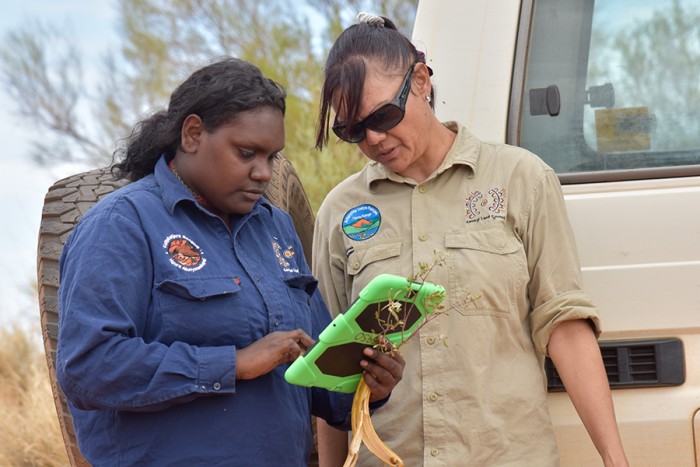
This Easter Aboriginal rangers will fan out across millions of hectares between the deserts of Central Australia and the Indian Ocean for the first cross border surveys of the endangered Greater Bilby (Macrotis lagotis)
Twenty ranger groups from the Northern Territory and Western Australia are combining their local knowledge and tracking skills with digital technology to conduct hundreds of base line bilby surveys by recording tracks, scats, diggings and burrows on Aboriginal land during March and April.
The data will update and expand our existing knowledge about the bilby’s distribution and inform the national bilby recovery plan – the first national threatened species plan developed with significant input from Aboriginal land managers.
Tomorrow at 10 am the Central Land Council rangers and other staff will join Australia’s Threatened Species Commissioner Dr. Sally Box at Hamilton Downs near Alice Springs to launch the Bilby Blitz at their annual ranger camp.
“A century ago bilbies roamed across most of Australia,” said ranger co-ordinator Josie Grant from the Central Land Council.
“Feral cats, foxes, cattle, donkeys, rabbits, camels and changed fire regimes have pushed bilbies to the edge of extinction. Today their last refuge is the land we manage and we’re really their last hope.
We’re protecting them through cool season burning and eradicating feral animals and weeds but because we’re all looking after huge areas of country we need a better handle on where our efforts will make the greatest difference.”
Ms Grant is on the indigenous subcommittee of the Commonwealth’s bilby recovery team, the first such indigenous advisory committee at a national level.
The rangers’ main weapon in the Bilby Blitz is the bilingual Tracks app, a mobile threatened species app in English and Warlpiri developed by the CLC as part of a comprehensive data collection, storage and management system linked to the CSIRO’s Atlas of Living Australia.
“Our Warlpiri rangers love the app,” said Ms Grant who grew up in the Tennant Creek region and speaks Warlmanpa and Warrumungu.
“The rest of us use the English version and can’t wait until we can afford to develop it in our first languages as well.”
The app, which can be downloaded from the Google Play store, collects the rangers’ tracking data in a standardised way, allowing the results to be analysed across time and sites and to be compared with future surveys.
This will enable land managers and conservationists to detect local changes in biodiversity, as well as monitor broader impacts of feral species and climate change across Australia’s desert regions.
“The Bilby Blitz is a ground breaking threatened species program for a culturally significant animal, a two-way ecological case study that demonstrates the critical role Aboriginal people play in protecting our country,” said CLC director David Ross.
“Seeing the Commonwealth develop the bilby recovery plan with Aboriginal land managers in the driver’s seat gives us real hope that there’s the political will to also resource and implement this plan,” Mr Ross said.
“However, our rangers will not wait to find out but get on with their vital conservation work regardless.”
The CLC is hosting the Bilby Blitz on behalf of the Indigenous Desert Alliance, with one-off funding from the federal environment department.
Its 12 ranger teams will be joined by rangers from the Kimberley Land Council, Kanyirninpa Jukurpa, Central Desert Native Title Services, the Ngaanyatjarra Council and other land management groups.
